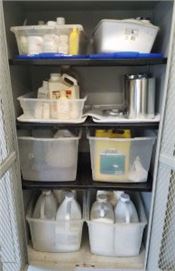So, You Want To Be A Pesticide Applicator: Private Applicator Competencies

Figure 1. Private applicators must show minimum core competencies to become certified applicators.
Photo: Ric Bessin, UK
DR. RIC BESSIN
PRINCETON, KEN.
The Environmental Protection Agency (EPA) regulates the registration, distribution, sale, and use of pesticides by their authority through the Federal Insecticide, Fungicide, and Rodenticide Act (FIFRA). There are two types of certified pesticide applicators defined by FIFRA: private and commercial applicators. Certified applicators are permitted to purchase and use most Restricted Use Pesticides (RUP).
Private applicators are certified to apply pesticides for the production of an agricultural commodity on land they or their employer owns or rents, or on the property of a neighbor in exchange for services, but they cannot be paid. Other certified applicators not fitting this description must be commercial applicators. In Kentucky, private applicators are trained every 3 years through their local county Extension office. The EPA has established the minimum core competencies needed to be a certified private pesticide applicator.
As part of their training, private applicators need to show practical knowledge of understanding pest problems and control practices associated with agricultural operations. Pest problems include insect, mite, weed, rodent, and/or associated disease issues. They should have knowledge of common pesticidal and non-pesticidal controls used to manage these problems.
Private applicators also must know how to properly store, use, handle, and dispose of pesticides and containers. We minimize the risk to ourselves, others (including children), and the environment by properly storing, using, handling, and disposing of pesticides and their containers. It is the legal responsibility of private applicators to store, use, and dispose of pesticides correctly.
Private applicators must have the ability to read and understand pesticide labels and labeling. When you have questions about a pesticide, reading the label is the first place to look for the answer, but you need to know how to read and understand the label.
The label will describe the active ingredient(s) in the pesticide, minimum personal protective equipment needed when handling the product, first aid in the case of poisoning, product-specific precautions and restrictions, restricted entry intervals (REI), pre- harvest intervals (PHI), directions for use, storage and disposal requirements, and provide a signal word indicating the relative risk of the product. The first sentence in the directions for use section is “it is a violation of federal law to use this product in a manner inconsistent with its labeling.” What this means is that the label is the law; applicators are required to follow all label directions.
Applicators can only apply pesticides according to labeling instructions and warnings.
Private applicators need to be able to recognize common pests and damage caused by them. Proper identification of diseases, insect, and weed pests is key to pest management and use of pesticides. In cases where applicators cannot accurately identify a problem, they should know where the can go to identify problems.
Private applicators must also be able to recognize local environmental situations to be considered during application to avoid contamination.
This includes weather conditions that may increase off-site pesticide movement and setbacks from creeks, rivers, ponds, and sink holes required on some pesticide labels. This also includes knowledge of endangered or threatened species in the area that may be impacted by certain pesticides.
Finally, private applicators need to be able to recognize pesticide poisoning symptoms and know the procedures to follow in case of a pesticide accident. Anyone who may be exposed to pesticides should be aware of the signs and symptoms of pesticide poisoning. Prompt action during pesticide overexposure can prevent serious consequences. Some poisoning signs that can be seen by others include, vomiting, sweating, or pin-point pupils. Other symptoms may be described by the victim of poisoning and include nausea, headache, weakness, dizziness, and drowsiness. If pesticide poisoning is suspected, medical attention must be provided for the victim, and the medical personnel provided the labeling for the pesticide in question. ∆
DR. RIC BESSIN: Entomology Extension Specialist, University of Kentucky

Figure 2. Proper pesticide storage helps to maintain the effectiveness of pesticides while protecting children, pets, others unfamiliar with pesticides, and the environment.
Photo: Ric Bessin, UK